The Yuuzhan Vong—"Children of Yun-Yuuzhan", also called the Chosen Race, known to the Chiss and Ferroans as the Far Outsiders, and sometimes incorrectly abbreviated to Vong (which implied that one was disowned by their family and their gods)—were a nomadic extra-galactic sentient species that nearly destroyed the New Republic, and were responsible for the deaths of over 300 trillion sentient beings during their invasion of the galaxy.
The Yuuzhan Vong originated outside the known galaxy. A typical Yuuzhan Vong resembled a Human in form, though they were taller and heavier than the average Human and had less hair on their heads. The Yuuzhan Vong were religious zealots, who viewed mechanical technology as blasphemy. Their technological innovations were genetically engineered and purely organic. Additionally, the Yuuzhan Vong deeply respected pain to the point of sadomasochism and strove to improve their physical capabilities through organ grafting. Such grafting was a status symbol within Yuuzhan Vong society.
Perhaps most notably, the Yuuzhan Vong were unable to be sensed through the Force. This confounded the Jedi who first encountered the Yuuzhan Vong. However, they were susceptible to some Force based attacks.
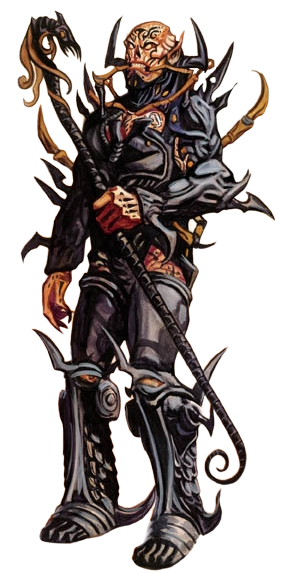
A Yuuzhan Vong warrior
The Yuuzhan Vong were a humanoid species—initially leading some to believe that they were a Human offshoot race—but there were differences between Humans and Yuuzhan Vong. For example, Yuuzhan Vong typically lacked kidneys. The Yuuzhan Vong were also much taller and had heavier builds than the average Human, though this could be a result of selective breeding. Yuuzhan Vong also had an average lifespan of 76 standard years, but their maximum lifespan was two to three times that of an average Human's. Genetically, they shared many elements that made them similar to Humans, which was considered unusual as they were an extragalactic species, but one notable difference was one element of their genetic structure that was present in all their biotechnology.
Yuuzhan Vong had sloping, almost ridge-like foreheads. Several Yuuzhan Vong had been seen with pointed ears, while just as many had been seen without them. These could have been ritual mutilations, or a genetic variation; there is no conclusive evidence as to what the species' norm was. Yuuzhan Vong also had short, stub-like noses, making their faces appear skull-like. The Yuuzhan Vong usually had black hair, though in lesser amounts on both the head and body than Humans, but often wore it much longer than them (in many cases, they were also completely bald). Small blue sacks could be found under the eyes of the Yuuzhan Vong, and they were often considered a mark of beauty. These eyesacks expanded and contracted to reflect a Yuuzhan Vong's mood, as the species did not use the facial expressions preferred by Humans. Through the blue sacks under their eyes, they were capable of telling if an individual was in delight or were suffering from rage. The most common skin tone among the Yuuzhan Vong was gray, with the second most common being yellow. Another major characteristic was their jet black blood.
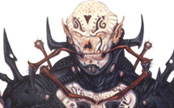
A Yuuzhan Vong's face
The Yuuzhan Vong nervous system was very conductive, as if it was made specifically for feeling pain. This nervous system was noted as containing aspects that were not found in Humans and likewise, there were elements within a Human nervous system that were not found in a Yuuzhan Vong. It was also noted that their tissue was very different from a Human's, which made the use of the Yuuzhan Vong Qah cells difficult on them as the Human brain eventually rejected the cells.
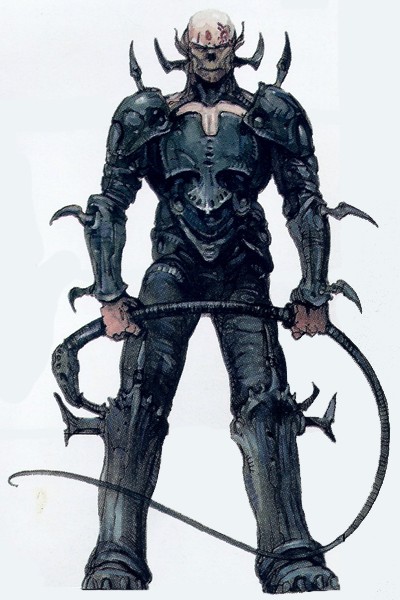
A Yuuzhan Vong warrior
Perhaps the most notable and most disturbing (to Jedi and other dwellers of the galaxy) trait of the Yuuzhan Vong was that they were outside of the Force as the Jedi knew it. They had no Force presence that could be sensed, and were unaffected by most Force powers that were targeted directly at them. This meant that any attempt to sense their motivation, truthfulness or determine their next course of action were futile, although it did mean that one was capable of detecting them by reaching out in the Force and determining if the person had no presence within it. Even a normally powerful telekinetic blast that was capable of launching an ordinary opponent off their feet at high speeds simply caused a Yuuzhan Vong either to stumble, or lose balance temporarily. While it was mostly impossible to affect the Yuuzhan Vong directly through the use of the Force, it was possible to use indirect means to accomplish such a task, such as manipulating an object through telekinesis and throwing it at a Yuuzhan Vong, which would injure them, or by controlling the air in an attempt to increase the pressure, thus allowing a Jedi to, in effect, crush the Yuuzhan Vong. The only known Force techniques that seemed somehow exempt from this limitation were variations on Force lightning/Emerald lightning, the dark side technique Force net, Dark Transfer, and to an extent Shatterpoint.
A small number of Jedi developed another ability, the Vongsense. In some ways, this ability worked similarly to the Force, especially the detection and telepathic aspects of the Force, but only relating to the Yuuzhan Vong and their biots.
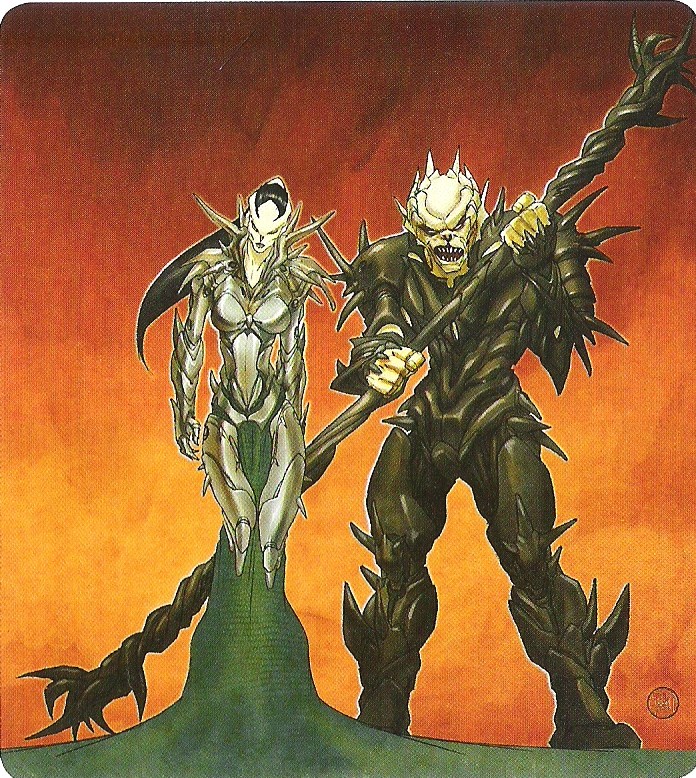
A female and male Yuuzhan Vong
Yuuzhan Vong culture was centered around sacrifice and their gods, although warriors in particular were centered on the philosophy of pain. They tended to glorify pain; not as a motive for action, but rather as a state of living. This was because they believed that, just like their gods had sacrificed their bodies to create the galaxy, the Yuuzhan Vong themselves were to sacrifice parts of their body for a greater purpose. As such, they believed that, by remaking their own bodies, they were becoming closer to their deities. While this was the case, they never maimed their bodies in a manner that would permanently hinder their ability to function. This resulted in individual Yuuzhan Vong having mottling or scarring, and sweeping tattoos. The more elite individuals were even known to graft organs from other creatures into their bodies. Devotional practices to the gods called for bloodletting at prayer times. Shamed Ones were forbidden from attending religious ceremonies.
As a Yuuzhan Vong grew more successful in their life, they began the process of sacrificing body parts and replacing them with organs from another creature, thus enhancing their abilities. This was done so during the Escalatier Ceremony, where an engineered organism related to an Implanter began to make cuts and incisions, and place the implants. At times, the implant was accepted into the body and the Yuuzhan Vong was promoted to a higher rank. However, there were occasions where the implant failed to be accepted into the body. This resulted either in death or the individual becoming a derided Shamed One. Such failures were believed to have been the work of the Yuuzhan Vong gods, though there were times that such a happenstance was due to the failure of the Shaper in charge of the Escalation ceremony.
Family was noted as being a strong element within their society. A member of the Yuuzhan Vong was typically associated with a family group, known typically as a Domain. Some Domains were more powerful than others. In addition to this family structure, the Yuuzhan Vong also employed a caste based system which included respective castes for warriors, shapers, priests, intendants and workers. Love affairs between two different castes was considered forbidden. In fact, domain loyalties ran deep, and went far beyond simple likes or dislikes. There were a series of ritual statements that a Yuuzhan Vong was required to utter as part of protocol from a member of lower ranks to a member of a higher rank. While this was the case, members of one caste were not obligated to salute a superior from another caste, which was the case with intendants to higher ranking members of the warrior caste.
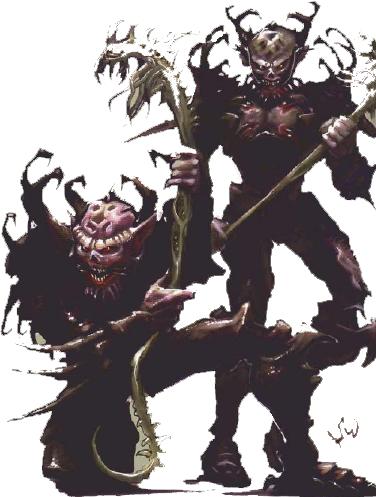
Two members of the Yuuzhan Vong species
Yuuzhan Vong children were raised in caste-specific crèches by designated caretakers, and likely did not know their biological parents until they were older. Their crèche parents named them. Deformed children were killed at birth, but, if the deformity was mild enough, as was the case with one Ona Shai, the child was spared. A useful survival trait for these children in order to live through such a harsh and competitive environment was paranoia. Twin births were uncommon events; only a handful of cases were known to the New Republic, in which each was thought to be a portent of a great event. In each case, one twin killed the other as a prelude to a great destiny. Funeral processions were typically carried out in a way that did not preserve the dead, and Yuuzhan Vong mortuaries often consisted of Yuuzhan Vong mourners who met with assigned priests. During such conditions, priests were involved in removing various body parts of the dead in order to dedicate them to the various gods.
According to the insights of an Imperial officer, the Empire and the Yuuzhan Vong had some elements that were common to one another. These included the need for strict discipline and the obedience to one's superior officer. However, at the time of the invasion, it was believed that their ultimate goals were completely different, with the Yuuzhan Vong desiring to change the way of life of the inhabitants of the galaxy. One of their goals was the destruction and removal of all forms of manufactured technology, which was one of the key strengths of the Imperial Remnant. This great belief in discipline and obedience in one's superiors meant that subordinates never contradicted their leaders; they were capable of subverting or altering the will of their commanders, but did not point out errors in that will. They were ultimately highly skilled warriors who never retreated in the face of defeat, as they feared this would insult their gods. While this was largely the case, it was known that certain Yuuzhan Vong were capable of cowardly actions. For actions like this, they became Shamed Ones.
Yuuzhan Vong beliefs highly influenced their actions and personality. According to their religion, life was suffering, and death was the ultimate release from that suffering. As such, the Yuuzhan Vong felt that nothing could be learned unless it was purchased in pain, and were resigned to and willingly went to their deaths. Some amongst their race, such as Domain Shai, went as far as to inflict pain on themselves to the point that they enjoyed it. Such groups felt that the infliction of pain was a means of earning the favor of their deities. Furthermore, it was believed that the greatest glory was death in battle. This fixation on death varied depending on the circumstances, as dying in the cold void between galaxies was considered a disgraceful death. Consequently, this meant that most Yuuzhan Vong fought to the death and thus also meant that other empires had very few opportunities of exploring the extragalactic aliens' organic warships. In addition, the priests claimed that they did not ask of others what they themselves did not accomplish, meaning that they equally sacrificed their own numbers as well as "infidels". This was an act of service to their deities, who were believed to have sacrificed their body parts in order to create all of existence.
The species also greatly believed in honor, with that subject ranking quite high in the beliefs of certain members of the race. Even under interrogations, the word of a Yuuzhan Vong was high, and, if they promised respite to their victims for revealing information, they typically kept their word. In one case, a Yuuzhan Vong commander agreed to a personal duel over the fate of a planet and, if defeated, he agreed that his forces would spare that world. While the Yuuzhan Vong himself was sincere, his subordinates worked with the Warmaster to subvert that honorable combat. Furthermore, the denial of the right to honorable combat was seen as a disrespectful act, worthy of scorn from the warrior caste. In fact, warriors would even consider a single worthy opponent of fighting a single Yuuzhan Vong warrior at a time worthy of respect in regard to their bravery as well as their fighting skills. There also existed a similar concept to the Wookiee Life debt, which was known as Us-hrok. This was a display that showed eternal gratitude and loyalty to another for something they had done, and meant that the Yuuzhan Vong in question would fight to the death on that person's behalf. In regards to food, the Yuuzhan Vong held no great joy of eating and thus felt indifferent about gastronomic tastes. The only exception of this was if the enjoyment came from an event such as the slaying of a great beast during a ritual.
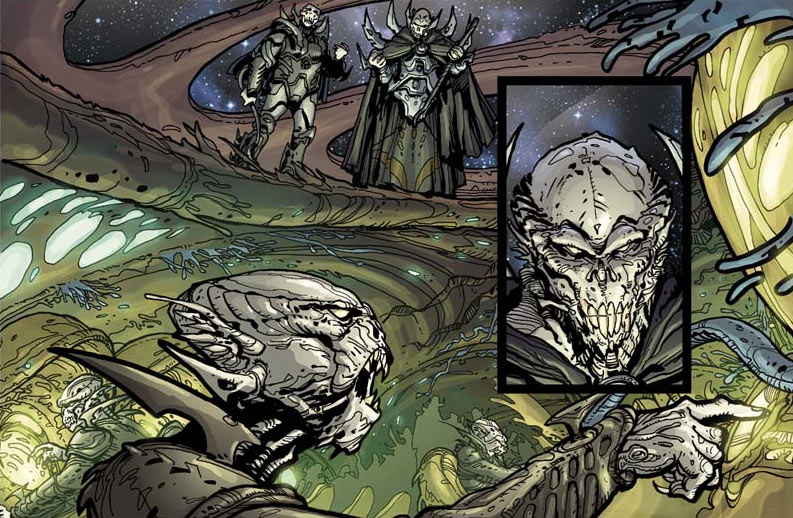
Yuuzhan Vong onboard their living ships
The psychology of the Yuuzhan Vong during wartime engagements was based around attack, and involved the use of high levels of aggression. This made them dangerous, though at times their actions were somewhat predictable. The Yuuzhan Vong were often encouraged by an enemy's resistance to them and tended to see such foes as being worthy of fighting. Internally, the Yuuzhan Vong greatly believed in the concept of competition as a means of breeding strength. However, this had the side effect of bringing about internal feuds between Domains and castes, who would attempt to escalate their positions above their kin. This resulted in civil war in the past, and it was believed that the Invasion would allow the Yuuzhan Vong an external enemy to fight, but after some time the same divisions began to appear once more. They also believed deeply in the concept of revenge, and had no reservations to the use of aggressive emotions—unlike the Jedi. This often meant that the Yuuzhan Vong engaged in suicide attacks or ritual suicides when facing defeat in order to attain glory, which was a source of pride of the warrior caste. This aggressive and warlike nature meant that they did not have any concept of peace or remorse. In their language, peace meant the willing submission to a conqueror. Furthermore, within their society, the use of profanities meant that the individual in question was capable of calling out a blood challenge to his opponent; the two would fight in a battle to the death. In addition, the use of particular insulting words, such as calling the other a "fool", meant that the wounded party was perfectly within their rights and even expected by their comrades to kill their opponent. This meant that an attack on a Yuuzhan Vong's pride was the grounds for demanding satisfaction, which was also capable of being accepted as a sacrifice to their gods.
The Yuuzhan Vong had a fanatical hatred of machines, believing them to be abominations and an affront to their gods. According to their beliefs at the time of the Invasion, they believed that combustion, the creation of fire through a machine, was the first abomination. This was because the Yuuzhan Vong believed deeply in life, but also felt that all life ended as in the wild; one type of lifeform was eaten by another, who in turn was devoured by another predator until it died, which replenished the ecosystem. This meant that death was prevalent constantly, but allowed new life to grow while machines did not die, meaning that they were capable of replacing organic life—which was something the Yuuzhan Vong would never allow.
The species possessed a saying: "Let the enemy fight", which was one of the aspects of their racial psychology. They often expected combat and arranged ambushes for their enemies, after which they baited targets into their traps. Their interdiction forces often remained outside their designated routes in order to jump onto a target, thus trapping them as a type of ambush. Another saying included "A fleet that fights two battles loses twice." Ultimately, the Yuuzhan Vong's earlier relations with other races was based on domination of the lesser species, as they felt most other races were unworthy. Those that managed to impress the Yuuzhan Vong and were considered worthy were often provided a clean death while the others were relegated to slavery.
Despite elements of their society which were seen as being barbaric, the Yuuzhan Vong truly revered life and all its forms. Among the few infidel races of the 'Promised Land', they tended to favor the Ho'Din, whose natural senses meant that they did not like the presence of advanced technology. Some primitive races who did not make use of technology were also known to have willingly allied with the Yuuzhan Vong, such as some of the inhabitants of Wayland. These "Wish-To-Bes" believed that the Yuuzhan Vong were like them in that they respected life, while the majority believed that this was not true, as the "Cut-Up-People" simply wished to harm as well as twist things to suit their needs. According to their religion, they had to prove themselves worthy creations of their deities, and if they did not do so then they would be destroyed—after which they would be replaced by a more worthy species. Their beliefs stated that this had happened three times in their religion, with a new species created, eventually leading to the gods creating the Yuuzhan Vong.
In the post-War period, the Yuuzhan Vong became a deeply spiritual as well as introspective people. Many felt that they would never be able to mend relations with the inhabitants of the galaxy due to the Yuuzhan Vong War, though a few heroic members of this race believed that they needed to evolve in order to survive. Thus, they felt that the journey to better relations was one that was worth the effort. They still retained their different form of honor in this age, with both custom and ritual still being an important aspect of their culture.
A Yuuzhan Vong glyph
The Yuuzhan Vong functioned in a caste system. This ranged from the powerful one-person Supreme Overlord to the lowly, oppressed Worker caste. The political system of the Yuuzhan Vong was a theocracy, with the Supreme Overlord deriving his authority directly from his status as the voice of Yun-Yuuzhan. By the time of Darth Krayt's Sith Empire, the caste-based system was still present, with warriors and Shapers included.
The highest caste was Supreme Overlord, who had control over all other castes. During the Yuuzhan Vong's invasion of the galaxy, the Supreme Overlord was Shimrra Jamaane, or so it was believed, as he was secretly being controlled by Onimi. Only the Supreme Overlord had direct communication with Yun-Yuuzhan, the supreme god and creator of the Yuuzhan Vong.
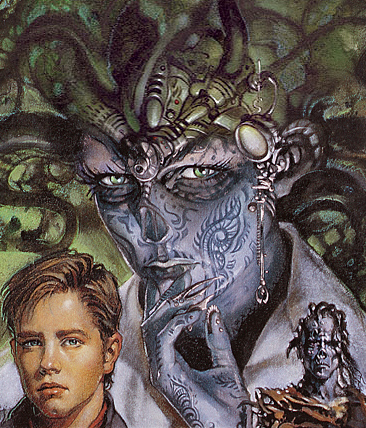
Mezhan Kwaad, a Master Shaper
Shapers were scientists who supervised the biotechnology of the Yuuzhan Vong. They focused on the creation and development of their organic technology and, together with the priests, observed the arcane developments related to it. Shapers were typically described as shorter than the average Yuuzhan Vong and were notable for their intricate tendril headdresses and Shaper hands. A Master Shaper's hand had 8 fingers, while that of an Adept had only 5. Each finger contained a different tool used in their work. Some Shapers, like Mezhan Kwaad and Nem Yim, hid weapons in their Shaper hand. Their headdresses appeared to have been tied directly to their nervous systems, and were used for ceremonial purposes to represent genuflection or compliance. They could also change shape to show the wearer's mood.
The shapers ranked very highly in Yuuzhan Vong society; their ranks included the Master Shaper, Shaper Adept, and Shaper Initiate also known as Shaper Novices.
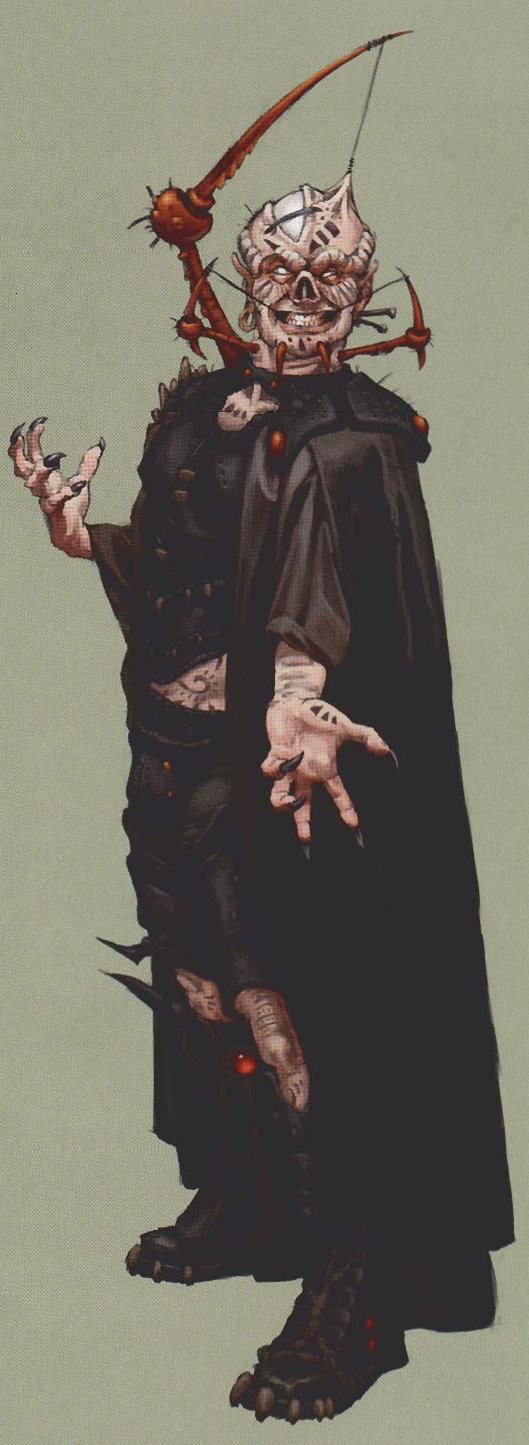
A priest
The priest caste was considerably powerful in the Yuuzhan Vong's rigidly theocratic society. The members of the priest caste served the many lesser deities that ruled the Yuuzhan Vong. There were several sects, each for the worship of a different Yuuzhan Vong deity. Ranks of the priest caste included the Mosthigh priest, High Priest(ess), Priest(ess), Seer, and Novice.
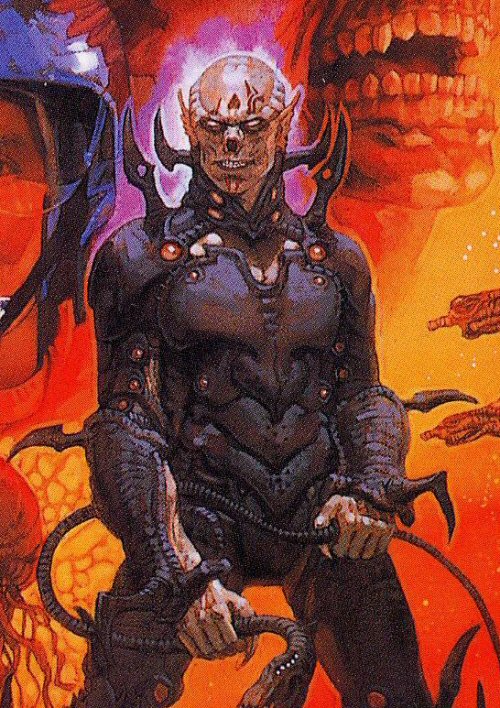
A Yuuzhan Vong warrior
The warrior caste served as the armies of the Yuuzhan Vong and was one of the largest castes who essentially served as the military branch of their race. Members of the caste were trained from an early age to excel in combat. Warriors were also more aggressive than other Yuuzhan Vong. Notable members of this caste included Tsavong Lah and Nas Choka, both of whom became Warmaster of the Yuuzhan Vong at various points. Their chief weapon was the amphistaff, which resembled a deadly serpent capable of spitting venom or coiling around foes. The warriors were devotees of the Slayer, Yun-Yammka, and sought honor in combat. They wore the living vonduun crab armor which was capable of resisting blaster fire or lightsabers. This armor did have weak points, such as points at the armpit and areas of the inner hip where the shell's segments joined.
Ranks of the warrior caste included the Warmaster, Supreme Commander, Commander, Subaltern, and Warrior.
The Intendant caste worked to keep Yuuzhan Vong society functioning and was as such responsible for the Yuuzhan Vong economy. They were noted as being the smallest of the castes who lacked a patron deity or a specific war cry when compared to the others. It was this caste that were in charge of matters of commerce, bureaucracy, trade and the management of the sizable slave work force employed by the Yuuzhan Vong. Notable Intendants included Nom Anor, the deadliest enemy of the Jedi. Members of the Intendant Caste could come from either the Shaper or Warrior castes. Shimrra Jamaane was formerly an Intendant, before becoming Supreme Overlord. They were the government and politicians and favored Yun-Harla the Trickster godess.
Ranks of the Intendant caste included High Prefect, Prefect, Consul, Executor, and Attendant.
The worker caste was the largest, yet lowest, caste and served mainly as servants, slaves and laborers. The worker caste included Shamed Ones, Yuuzhan Vong whose bodies had rejected any organic implants and modifications, Yuuzhan Vong born outright into the worker caste, Yuuzhan Vong who had failed to succeed in other castes, and conquered or shaped species such as the Chazrach. Slaves and the Shamed Ones (fallen members of society) were part of the worker castes, but they were treated with contempt even by their fellow workers, though Yuuzhan Vong born into the worker caste were actually descended from Shamed Ones.
The Yuuzhan Vong religion, called the True Way, was very important to the Yuuzhan Vong. They were devout and had many gods and, prior to their defeat, believed it was their duty to appease their gods' desires through conquest and genocide.
Yun-Yuuzhan, the creator, was the most powerful deity of the Yuuzhan Vong religion. He sacrificed most of his body parts to create the lesser deities and the Yuuzhan Vong galaxy. Only the Supreme Overlord had direct contact with him.
Yun-Harla was the Trickster, the Cloaked Goddess and goddess of deception and aggression. Yun-Harla represented the political caste. Having learned this information, the New Republic military had their top pilot, Jaina Solo, codenamed "Trickster" and "Goddess" in an act of psychological warfare against the Yuuzhan Vong invaders, who would believe they were fighting the living form of one of their most powerful deities.
Yun-Yammka was the Slayer, and the god of war. His image was of a multi-tentacled being, and was the inspiration for the form of the yammosk. He was primarily worshipped by the warrior caste. He was in actuality created by the priest caste when the Yuuzhan Vong turned to war.
Yun-Ne'Shel was the Modeler. She oversaw natural life cycles and was worshiped by the shaper caste.
Yun-Txiin and Yun-Q'aah were the Lover Gods and twins. Having a relationship outside one's caste was forbidden in Yuuzhan Vong society, and disobeying automatically led to sacrifice to the Lover Gods.
Yun-Shuno was the Pardoner. She had a thousand eyes and watched over and spoke for the Shamed Ones, who were shunned by every other Yuuzhan Vong deity. She was the only deity the Shamed Ones were allowed to worship.
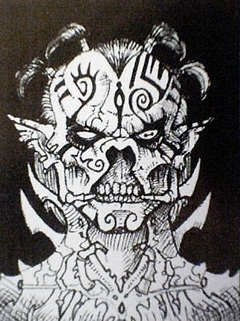
A Yuuzhan Vong
The Yuuzhan Vong were refugees from a distant galaxy. Their original homeworld, Yuuzhan'tar was a tropical planet that had a large asteroid belt around it. It was destroyed thousands of standard years before they invaded the galaxy.
In Yuuzhan Vong, Yuuzhan'tar meant "Crèche of the gods", and the living planet was a template for the Yuuzhan Vong deities. Yuuzhan'tar may have been the basis for Yun-Yuuzhan, the creator god of the Yuuzhan Vong.
Little was known about their early history, but the Yuuzhan Vong had apparently once lived as symbiotes with their homeworld and were Force-sensitive. Their technology was also largely organic. At some point in their history, the Yuuzhan Vong were caught in the midst of a devastating galactic conflict between two droid civilizations—believed to be the Silentium and the Abominor—which solidified their hatred of mechanical technology and xenophobia towards other sentient lifeforms.
The Yuuzhan Vong's living homeworld aided them in the war by bestowing upon them the knowledge of creating living weapons. However, as the war dragged on, the Yuuzhan Vong as a species became increasingly violent and warlike. Eventually, they were able to defeat their enemies, and forced both droid powers to flee their galaxy.
Following the war, the Yuuzhan Vong went on a crusade to cleanse their galaxy of all forms of mechanical technology. They conquered much of their galaxy and either exterminated or enslaved conquered species. Among those species they conquered were the reptilian Chazrach, which became slave soldiers for the Yuuzhan Vong.
With much of the galaxy in their hands, the various Domains (what the Yuuzhan Vong called clans or families) fractured and turned against each other, resulting in the devastating Cremlevian War. During the conflict, much of the Yuuzhan Vong's galaxy was destroyed, including their homeworld, Yuuzhan'tar. The exact details of the destruction of the planet were lost to the passage of time. However, Yuuzhan'tar did produce a seed which eventually became Zonama Sekot, later colonized by the Langhesi and Ferroans.
Separated from their original symbiosis with their homeworld, the Yuuzhan Vong were stripped from the Force, and experienced great pain. Thus, the species saw pain as the only way to return to that symbiosis and practiced body modifications on themselves. In place of their homeworld, the Yuuzhan Vong took up belief in several deities, which subsequently governed nearly every aspect of their civilization.
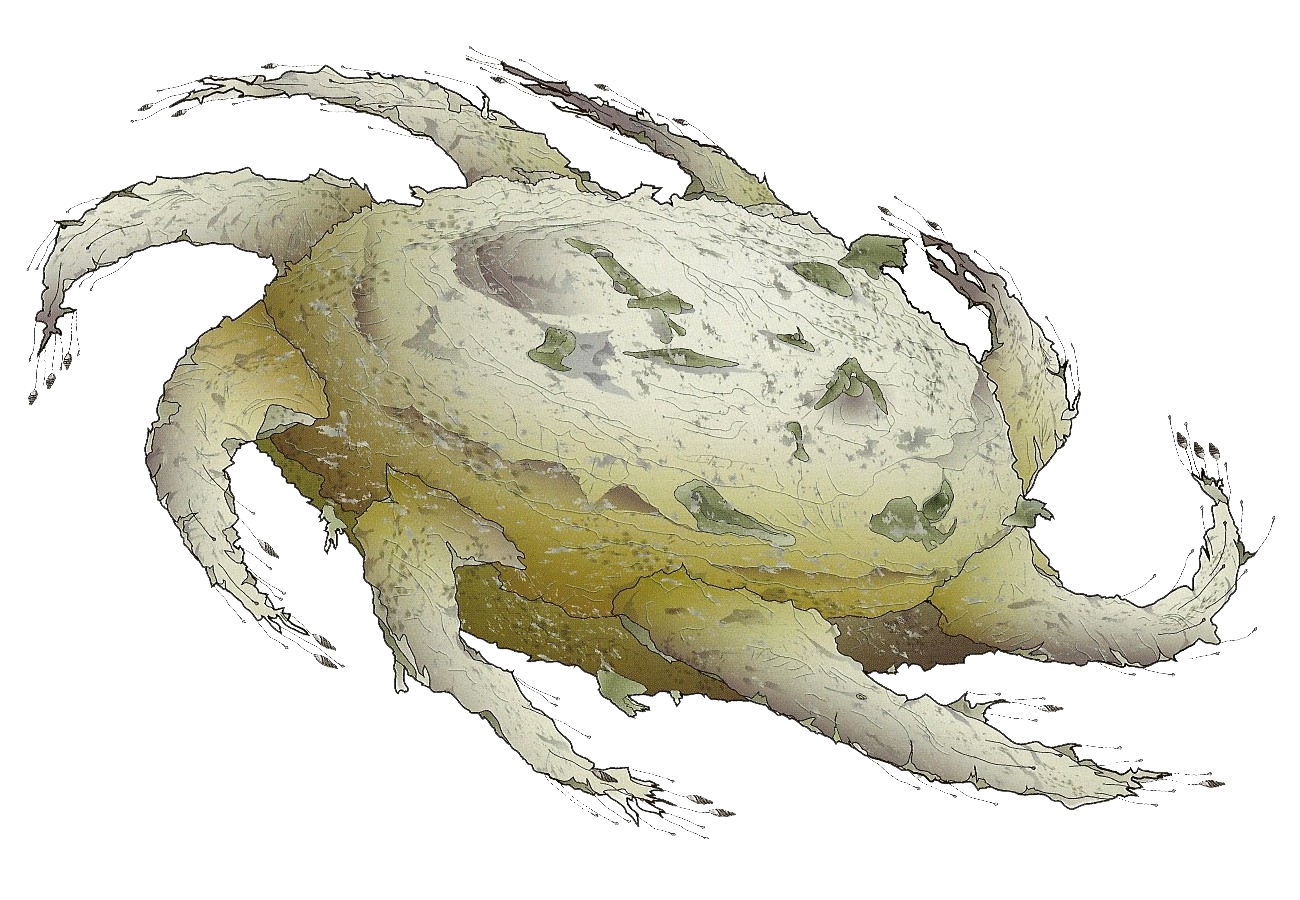
The Yuuzhan Vong made the exodus from their galaxy onboard their great Worldships.
Towards the end of the war, Steng emerged as the first Warmaster. A rival Warmaster, Yo'gand, invented the Yo'gand's Core tactic, which he used to destroy the planet Ygziir and its moon. The destruction of Ygziir resulted in the death of Steng and the end of the war. Eventually, Yo'gand united the Domains into a single socio-political entity and became the first Supreme Overlord of the Yuuzhan Vong.
With much of their galaxy ruined, the Yuuzhan Vong began a long trek to another galaxy in search of a new home. For a long period, perhaps centuries, the species was forced to travel through the Intergalactic Void in massive worldships. During this period, the Yuuzhan Vong nearly destroyed themselves. Violence and competition had been inevitably built into their society and, without an external target, they focused their aggression against each other. Though there were no all out wars in the magnitude of the Cremlevian War, the Domains continued to fight each other for the favor of the Supreme Overlords.
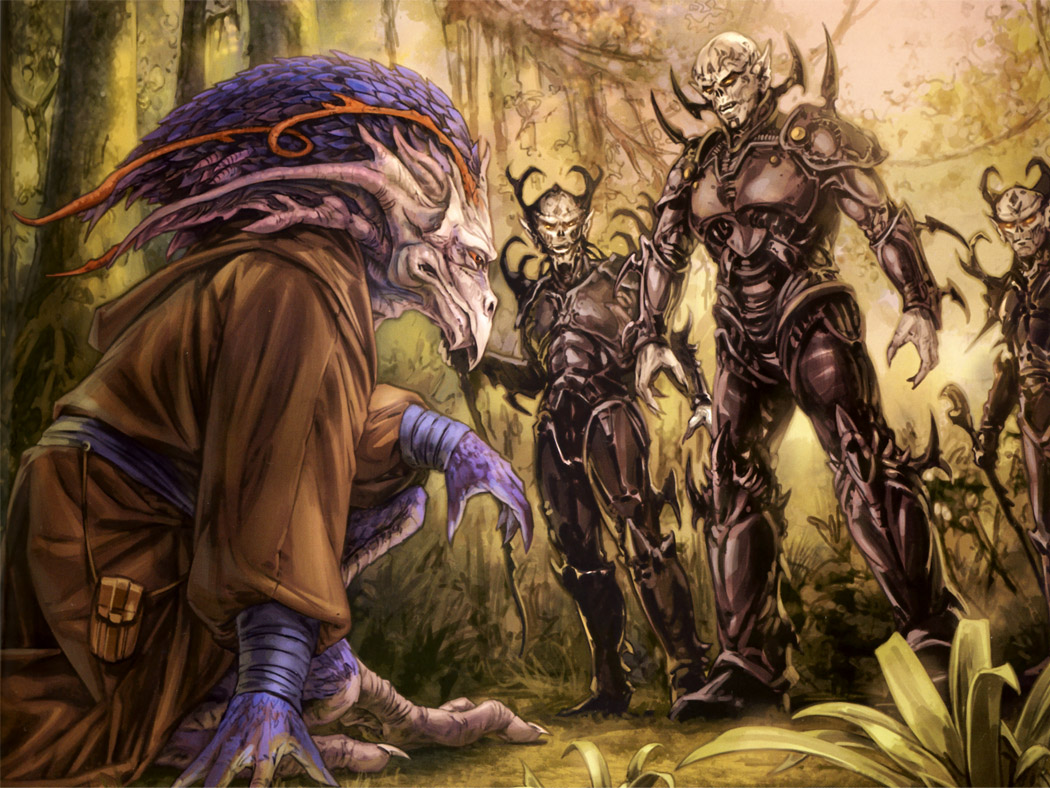
Vergere is captured by the Yuuzhan Vong
When the Yuuzhan Vong left their galaxy, how long their voyage took, or if they even knew what their destination would be, was unknown. At least one account spoke of their journey taking at least several millennia; however, by 26 ABY, one of the oldest worldships (old enough to be dying, and considered to be 'ancient') was less than 1000 years old. It would appear that by 3997 BBY, sometime after Exar Kun became the new Dark Lord of the Sith, the Praetorite Vong's slivilith probe creatures had arrived, and as of 3963 BBY, at least one scout had reached the Wild Space region of the known galaxy. In that year, a group of Mandalorian Neo-Crusaders under the command of Canderous Ordo encountered what would later come to be known as a Yorik-stronha, disguised as an asteroid in the Crispin system, while chasing a group of pirates in the system's asteroid belt. When Ordo used a thermal generator to melt the frozen methane covering the "asteroid", the Yorik-Stronha, in Ordo's words, "woke up". The asteroid began to spin quickly and then proceeded to fire plasma at the Mandalorians. The extragalactic weaponry was able to melt through the Mandalorian's armor "like wax". The attack on the Mandalorians became the "first contact" with the Known Galaxy. The probe fled soon after the brief battle with Ordo's Mandalorians. Ordo followed in hot pursuit, but was unable to keep up with the probe. The Mandalorians were able to track the probe's hyperspace wake to the edge of the galaxy, where the Neo-Crusaders turned back, apparently thinking that the mysterious ship was going on a suicide run into the great void outside the galaxy. Also in this general time frame, a female Shaper arrived in the galaxy in suspended animation, crashing on Lorrd and surviving there for several decades, interacting with locals who believed her to be a demon.
Between 229 and 89 BBY, the living planet Zonama Sekot—a seed of Yuuzhan'tar—arrived in the Gardaji Rift. In 33 BBY, a Yuuzhan Vong was captured and ended up in Cog Hive Seven, a prison colony wherein deadly gladiatorial matches regularly took place between inmates. The Yuuzhan Vong, who had already killed two fellow inmates in transit to the colony, quickly emerged as the station's most recent champion. For six months, the warrior systematically defeated every opponent pitted against the Yuuzhan Vong, until the champion was matched with Sith Lord Darth Maul, who was on an undercover mission on Cog Hive Seven. After a brutal fight, (where the Sith was under orders to not use the Force and, of course, could not passively sense anything of his foe's planned moves) Maul killed the warrior. As the Yuuzhan Vong had only spoken in the species' native language, the colony's systems had failed to classify its species, point of origin, or even gender, although some of the guards suspected that the individual was a female.
In 32 BBY, at the time of the Invasion of Naboo, an advance force of Yuuzhan Vong—termed "Far Outsiders" by the planet's inhabitants—discovered Zonama, and noting the similarity to Yuuzhan'tar (though not drawing the connection) attempted to colonize it. However, when the Yuuzhan Vong attempted to settle, Zonama Sekot's biosphere killed off the Yuuzhan Vong flora and fauna, provoking them. Although Sekot attempted to negotiate with them, they began an assault upon the planet. After two years of costly fighting, the assault was called off with the arrival of the Jedi Knight Vergere, who convinced the Yuuzhan Vong to leave on the condition that she would travel with them. The Galactic Republic received only shadowy news at the attack; even after Jedi Knight Obi-Wan Kenobi and his Padawan Anakin Skywalker went to investigate Vergere's disappearance, all that they discovered was that an unknown race of biotech-based aliens from a distant place and armed with weapons that the planet's inhabitants had never seen before had attacked the world.
In 29 BBY, after learning of Zonama Sekot, Supreme Overlord Quoreal's determination to invade began to waver. The Yuuzhan Vong soon learned that Zonama Sekot was no longer in its original system, and there was no evidence that it had been destroyed. Worried about the threat presented by the powerful planetary entity, he announced to his people that it would be best to move on to another galaxy. However, Shimrra Jamaane, under the influence of Onimi and with the support of some of the more aggressive domains, launched a coup, murdered Quoreal and took his place, ensuring that the invasion would go forth as planned. But it would still be some time before they were ready.
Information of Yuuzhan Vong activity within the galaxy for the next few decades is scarce. It is known that, by 27 BBY, at the start of the Outbound Flight Project, Palpatine had somehow gained knowledge of the incoming Yuuzhan Vong fleet, though he planned to withhold it from the Republic until after his New Order could be instituted. At least one of his subordinates, Kinman Doriana, was informed, however. The distant threat of invasion was also part of the reason Palpatine ordered the destruction of Outbound Flight in order to prevent its occupants from falling into the hands of the Yuuzhan Vong (and also to eliminate six Jedi Masters and twelve Jedi Knights). Following the end of the Clone Wars, Emperor Palpatine let out hints of the Yuuzhan Vong to the public. One of his official justifications for maintaining the Imperial Navy even after the war had ended was to ward off the threat of extra-galactic invasion.
It was also around this time that another small reconnaissance force of Yuuzhan Vong engaged the Chiss Defense Fleet, on the edge of the Chiss Ascendancy. Although the Chiss Admiral Ar'alani managed to defeat them, the Yuuzhan Vong fought much better than the Chiss had believed such a small fleet was capable of. The appearance of the Outbound Flight shortly afterwards led the CEDF high command to wonder for a short time if the invaders and the Republic were allies.
Sometime between 27 BBY and 22 ABY, it was speculated by some Chiss that the Yuuzhan Vong had made a pact with the Vagaari against the Chiss.
Yuuzhan Vong scouts returned dozens of kidnapped sentients to the fleet from the galaxy. Among them were Humans, Verpine, and Talz. They were interrogated and experimented upon, with many dying and others being sacrificed. Those who survived (such as Vergere) were awarded as familiars. Around 25 BBY, three years before the Clone Wars, the Yuuzhan Vong also established a small outpost on the planet Bimmiel. After the formation of the Galactic Empire, Imperial scientists established a base on the same planet, suggesting that Palpatine might have had direct contact with the invaders. However, the remains of the Yuuzhan Vong occupying the outpost went undisturbed until their discovery shortly into the Yuuzhan Vong invasion. It is also known that Yuuzhan Vong scouts were active in the galaxy during the Clone Wars.
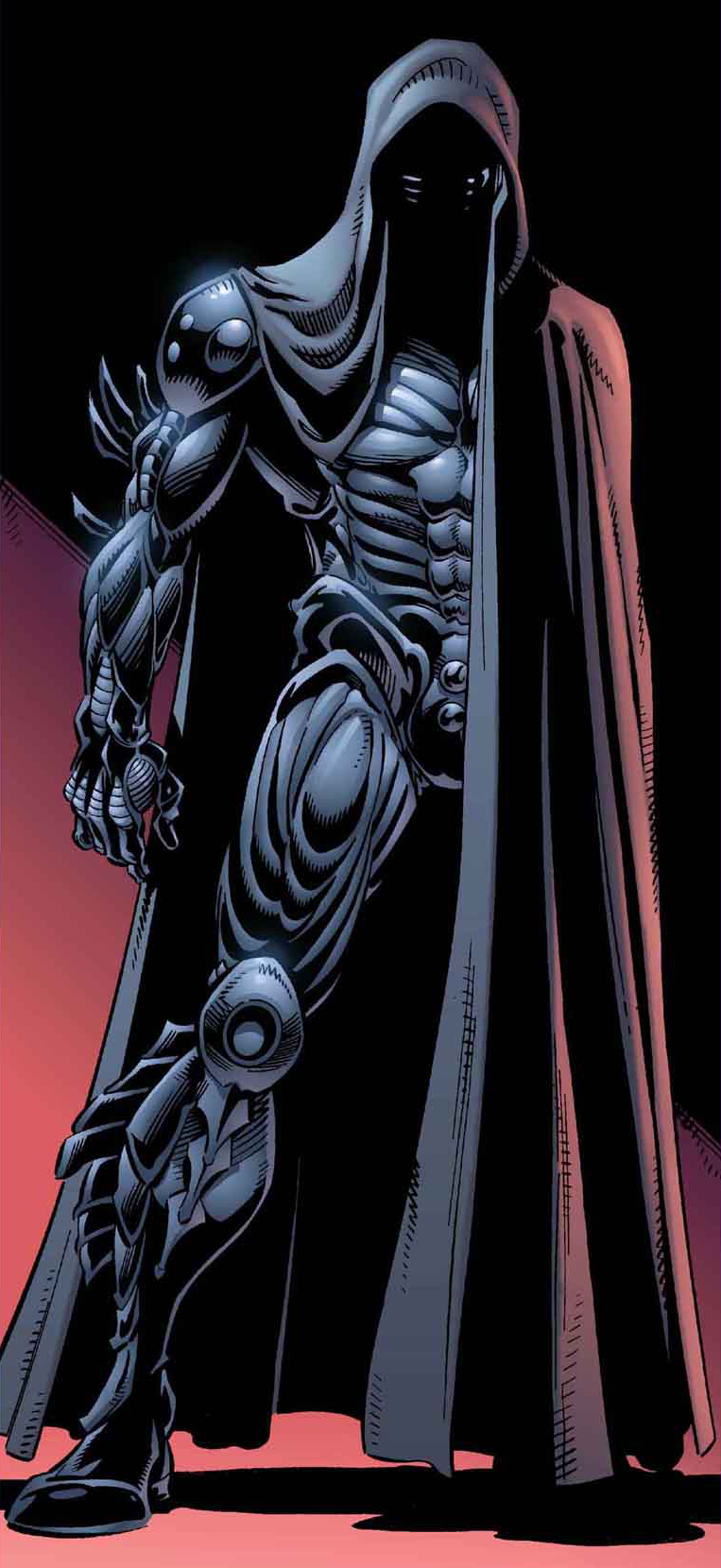
Nom Anor, agent of the Yuuzhan Vong
The Yuuzhan Vong advance scouts themselves shared that sentiment. After the formation of the Imperial Interim Council in 11 ABY, following the final death of the reborn Emperor Palpatine, Yuuzhan Vong executor Nom Anor was tasked to infiltrate the Council. He did so and manipulated its leader, Xandel Carivus, arranging the deaths of many Councilors and furthering the internal strife between the leaders of the fracturing Empire.
Meanwhile, the Yuuzhan Vong also began meddling in the high politics of the Ssi-ruuvi Imperium. They installed one of their own agents, E'thinaa, in a high-ranking military position, and manipulated the rise to power of the Keeramak, with the goal of eventually using the Ssi-ruuvi to create confusion and disorder during the Yuuzhan Vong invasion.
In 24 ABY, Yuuzhan Vong agent Yomin Carr infiltrated the ExGal Society, stationing himself at the ExGal-4 base on Belkadan located along Vector Prime.
In 25 ABY, Yuuzhan Vong executor Nom Anor struck a deal with Boba Fett to have him and a select group of Mandalorian aid the invasion force. Fett realized that openly resisting the Yuuzhan Vong would result in the enslaving of Mandalore and so he agreed. He secretly carried out a plan to aid the New Republic by allowing New Republic personnel to escape with information from doomed worlds. This resulted in the escape of the Jedi Knight Kubariet on the world of New Holgha.
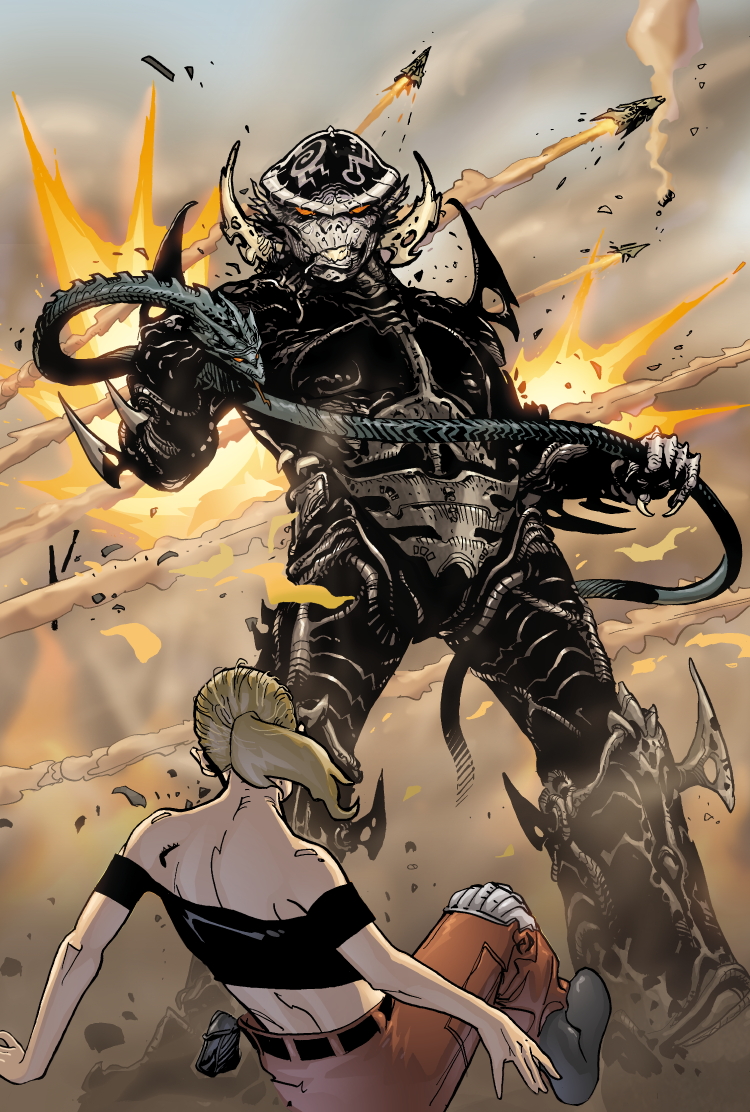
The Yuuzhan Vong invade the galaxy
On the world of Rhommamool, Yuuzhan Vong executor Nom Anor, disguised as the leader of the Red Knights of Life, stirred up a war between Rhommamool and its neighboring planet, Osarian. He was also responsible for infecting Mara Jade Skywalker and a hundred other diplomats with a deadly Yuuzhan Vong disease. As a result the New Republic did not take notice when the first of the invasion force, the Praetorite Vong, made planetfall on the distant world of Helska IV and also brought down Sernpidal's moon upon the planet, killing millions of beings including the famous Wookiee Chewbacca, and leaving the planet itself in pieces. The Yuuzhan Vong also encountered the Jedi, whom they started to consider the worst of a galaxy full of infidels, due in no small part to the Jedi's ability to control a supernatural force that Yuuzhan Vong had been denied. The Praetorite Vong were eventually defeated by galactic heroes Luke Skywalker, Han Solo, Leia Organa Solo and Lando Calrissian.
The main Yuuzhan Vong fleet arrived soon after though, and had in short order conquered many of the worlds in their invasion corridor. Bimmiel, Dantooine, Dubrillion and Obroa-skai were among the many worlds captured while Ithor was consumed by firestorms and rendered uninhabitable. Sheltering the refugees from planets in the invasion corridor quickly became such a problem that the New Republic government could no longer ignore the threat of the Yuuzhan Vong. The political leadership was ineffectual in countering the invaders though, and initially tried to blame the Jedi for starting the conflict with the aliens. The Yuuzhan Vong, considering the Jedi their worst enemies, capitalized on this by luring natives of the galaxy into turning in Jedi with the promise that they would be spared from the invasion. The Peace Brigade appeared as an organization of such individuals.
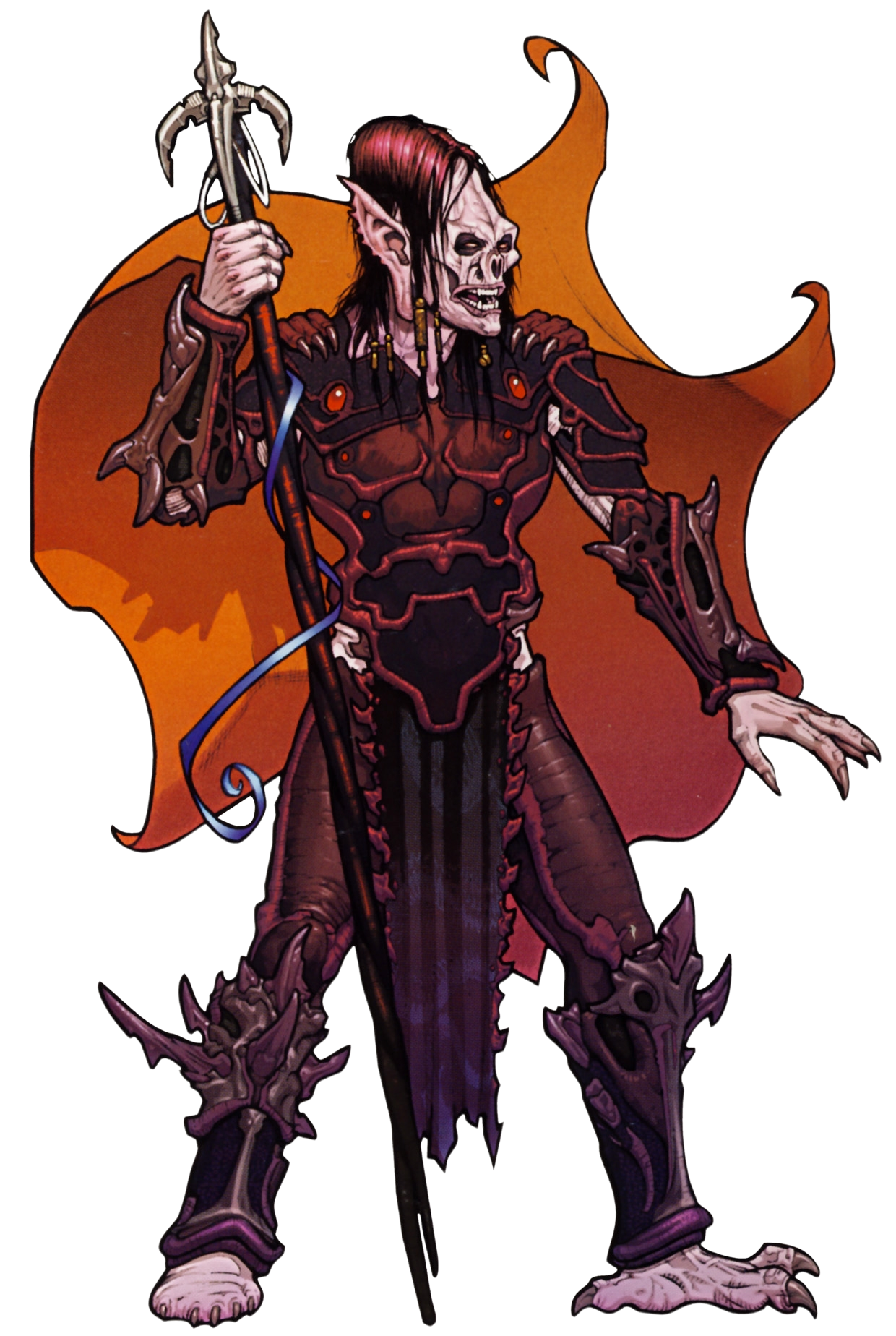
Warmaster Tsavong Lah
The Yuuzhan Vong also struck a deal with the Hutts that allowed them to pass through Hutt Space unmolested. But the Hutts secretly played both sides by passing information on Yuuzhan Vong fleet movements on to the New Republic. In return the Yuuzhan Vong ruthlessly conquered their worlds. In any case, moving through Hutt Space allowed the invaders to launch an attack against Fondor on the far side of the galactic core. However, they suffered heavy losses in the Battle of Fondor when Han Solo's cousin, Thrackan Sal-Solo, fired Centerpoint Station against them, destroying much of the defending Hapan fleet too.
Following the conquest of Duro, Warmaster Tsavong Lah offered the New Republic a cease fire if they turned over every single Jedi in the galaxy. The Jedi became hated as never before, with several planetary governments collaborating with the Yuuzhan Vong in hunting them down, and even resulting in the New Republic temporarily issuing an arrest warrant for Jedi Masters Luke and Mara Jade Skywalker.
The Peace Brigade also launched an attack on the Jedi Academy on Yavin 4 in an unsuccessful attempt to capture the children being trained there. The Yuuzhan Vong themselves arrived shortly after though, complicating the situation for the few Jedi remaining on the moon. The Yuuzhan Vong captured the Jedi trainee Tahiri Veila and started shaping her like the rest of their biological creations. However, before the experiment was completed, she was rescued by her best friend, Anakin Solo, with the help of the shamed Yuuzhan Vong, Vua Rapuung, redeeming the Shamed One in the process. As a result, a heretical movement that worshiped the Jedi as saviors gained popularity among the Shamed Ones (later led by Nom Anor), despite the efforts of the ruling castes to exterminate it. A short while later, the Yuuzhan Vong broke the cease fire by launching a surprise attack on Yag'Dhul.
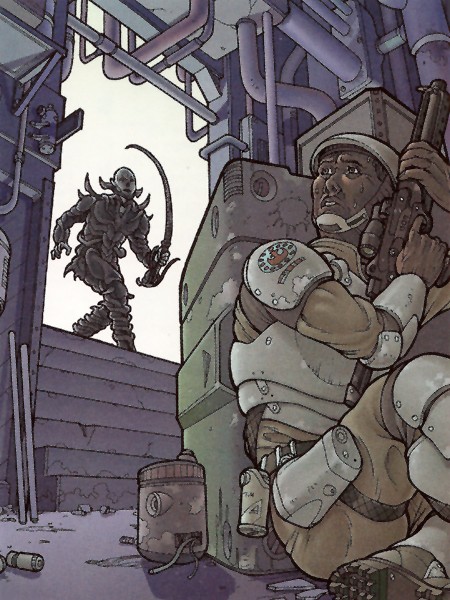
A single New Republic soldier tries to hide from the Yuuzhan Vong, while the New Republic crumbles under their relentless invasion
Two years into the war, the Yuuzhan Vong unleashed a new biological creation, the voxyn, for the purpose of hunting down the Jedi. In response, Anakin Solo formed an all-Jedi strike with the intent of hunting down the Voxyn Queen from which the Yuuzhan Vong cloned all the other voxyn. The mission was a success, but came at the cost of the lives of nearly half the team, including Anakin Solo himself, and also left his brother, Jacen Solo, captured by the Yuuzhan Vong. Meanwhile the Yuuzhan Vong launched an immense attack on Coruscant, conquering the capital of the New Republic and killing Chief of State Borsk Fey'lya. Following that, they renamed the planet Yuuzhan'tar, and started Vongforming the planet in the image of their long lost homeworld. The Vongforming of Coruscant was sabotaged by Jacen Solo before he escaped from captivity with the aid of Vergere. The Yuuzhan Vong began to also suffer from internal problems, as the stresses of maintaining an Empire began to tax their resources.
The New Republic, having moved its capital to Dac, elected Cal Omas to replace Fey'lya, who also created the High Council, which would coordinate the Jedi's role in the war. At the same time the Jedi also found out about the NRI's secret project to create Alpha Red, a biological weapon that would wipe out the Yuuzhan Vong and all of their creations. The Jedi were unable to convince Cal Omas to ignore the weapon as a viable option for countering the invaders, but the rogue Jedi Knight Vergere saved them the trouble by destroying the project herself. However, the incident strained the relationship between the Jedi and the New Republic.
Forced to pursue conventional warfare while the Alpha Red team started from scratch, the New Republic hatched a plan to lure the Yuuzhan Vong into a trap in the Deep Core, centered around the moon, Ebaq 9. Using Jedi Knight Jaina Solo as bait, the trap was successfully sprung on the Yuuzhan Vong fleet, destroying it. On Ebaq 9, Warmaster Tsavong Lah himself was slain by Jaina Solo and Vergere sacrificed herself to eliminate the rest of the Yuuzhan Vong troops that had landed on the moon. Omas, using the political clout and fearing that the Senate would try to hijack control of the war, drafted a new constitution which stripped the Senate of executive power, turning the New Republic into the Galactic Federation of Free Alliances (Galactic Alliance or GFFA for short).
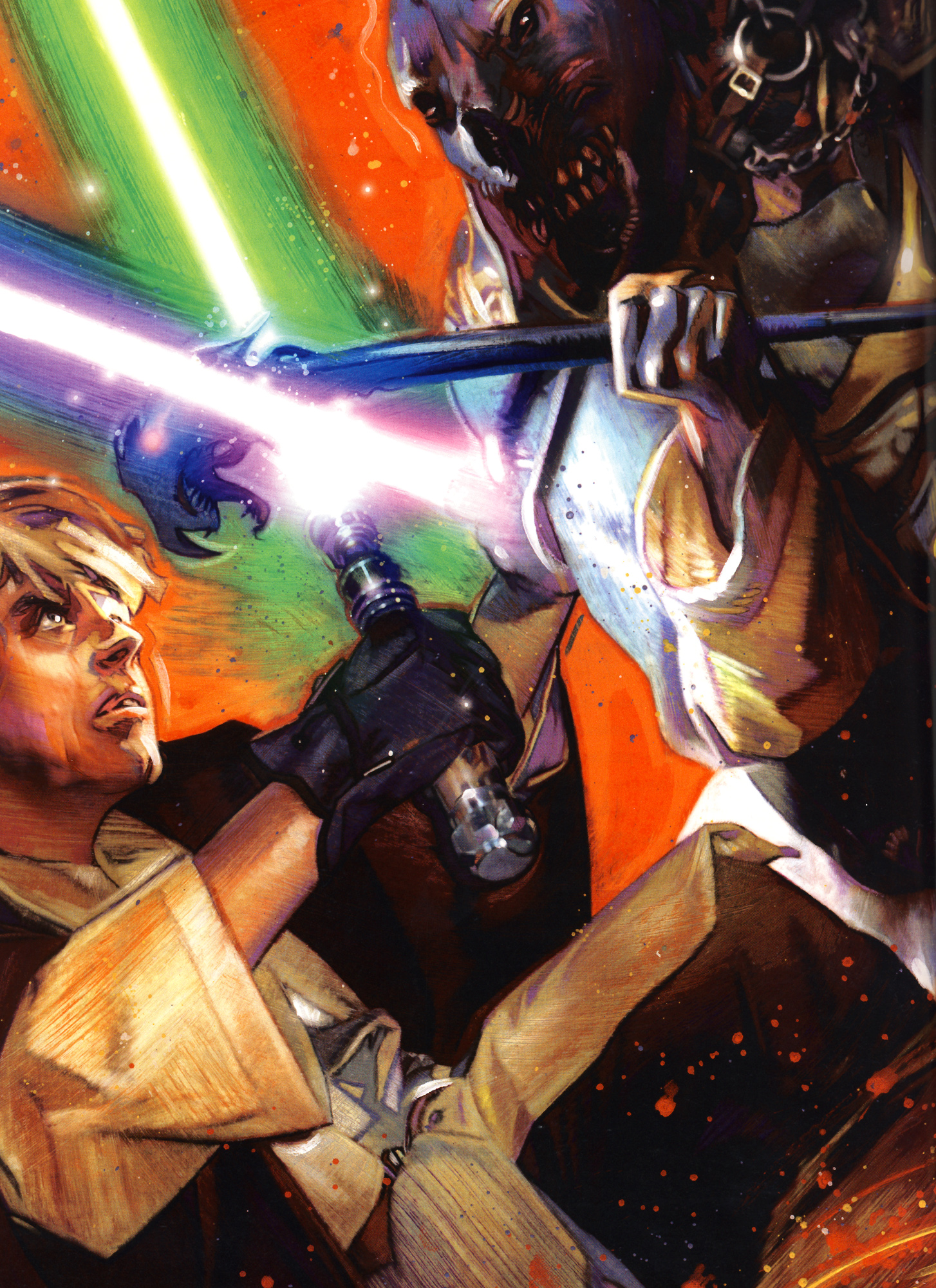
Luke Skywalker battles Supreme Overlord Shimrra Jamaane to the death
After the victory, Luke Skywalker put together a team to follow up on Vergere's information about the living planet of Zonama Sekot. They traveled into the Unknown Regions, receiving help from both the Imperial Remnant and the Chiss, though only after having provided a service in return. Eventually they found the living planet and entered negotiations in an attempt to convince it to help end the war.
Meanwhile, Executor Nom Anor, disgraced for his role in the disaster at Ebaq 9, disguised himself as the prophet Yu'Shaa and began stirring up heresy on Yuuzhan'tar (formerly Coruscant). He heard about Zonama Sekot and succeeded in putting together a mission to the living planet consisting of himself (still in disguise), the Shaper Nen Yim, the Yuuzhan Vong priest Harrar and the two Jedi Knights Tahiri Veila and Corran Horn. The five made it to Zonama Sekot where Nom Anor showed his hand and killed Nem Yim and pushed Harrar over a cliff before trying to sabotage the planet's hyperdrive. The two Jedi were unsuccessful in undoing his sabotage or preventing him from escaping the planet, but Zonama Sekot appeared to know what to do as it launched itself into hyperspace and traveled to Yuuzhan'tar, taking up orbit around the same star as the former capital of the galaxy.
During this time, the Galactic Alliance had prepared to make a push for Yuuzhan'tar and take the planet back, and hopefully also break the Yuuzhan Vong's ability to wage war by taking out the Supreme Overlord. In the end, Supreme Overlord Shimrra was revealed to be nothing but a puppet for the real leader of the Yuuzhan Vong, the Force-sensitive Shamed One Onimi. Shimrra was killed by Luke Skywalker and Onimi was later killed by Jacen Solo during the second battle of Coruscant. Nas Choka, Lah's successor as Warmaster, became de facto Supreme Overlord, and ordered the remaining Yuuzhan Vong warriors to surrender.
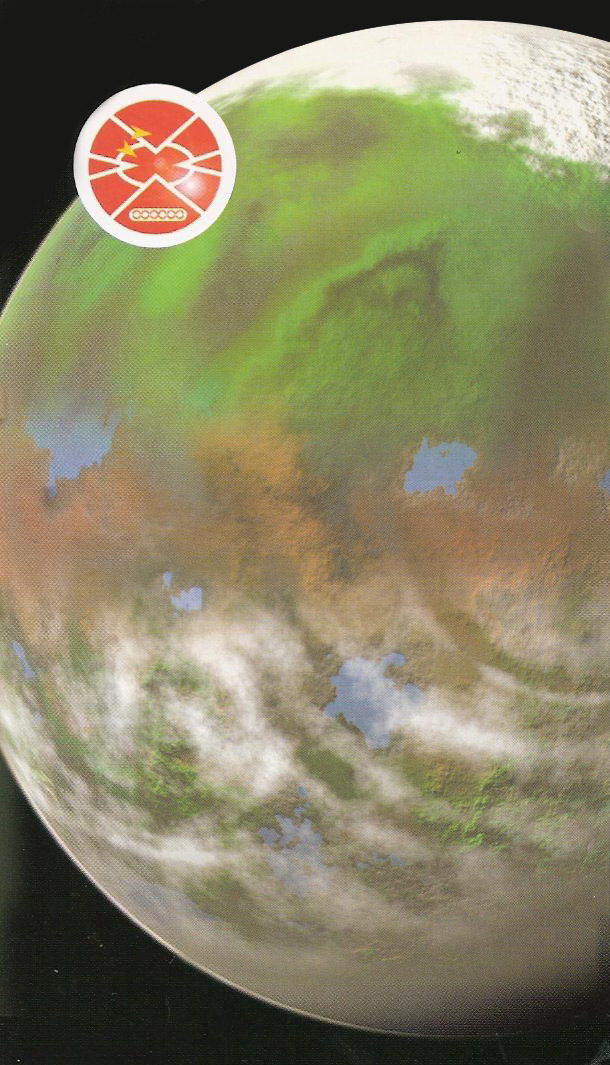
Zonama Sekot, the new homeworld of the Yuuzhan Vong
One of the terms of the Yuuzhan Vong's surrender was also that they help rebuild Coruscant to be suitable as the capital of the Galactic Alliance. The Galactic Alliance settled on Denon while construction went on, and eventually back to Coruscant after the rebuilding was complete.
Zonama Sekot also revealed itself as the seed of the long-dead original Yuuzhan Vong homeworld. After the end of the war, the remaining Yuuzhan Vong were recalled from across the galaxy to Zonama, to be contained there (except for designated Vong required to perform duties mending the harm their people had done, any who refused exile were to be put to death). Zonama Sekot, with its new Yuuzhan Vong population, then disappeared back into the Unknown Regions, so that the Yuuzhan Vong could live in peace and renew their relationship with Sekot. Among other things they planned to attempt to abolish their caste system, and had already eliminated the posts of Warmaster and Supreme Overlord (though Choka seemed to remain the de facto leader of the species).
The Bothans, however, were unforgiving for the death of Fey'lya, and continued to uphold their declared state of ar'krai genocide against the Yuuzhan Vong, sending ships into the Unknown Regions to hunt for Zonama. By 36 ABY their efforts had been somewhat foiled by the Galactic Alliance, which had impounded the ship detailed for the expedition.
The Yuuzhan Vong war was possibly the most devastating crisis the galaxy had faced. The cost in lives were staggering; the number of deaths over the known galaxy were estimated at about 300 trillion sentients.
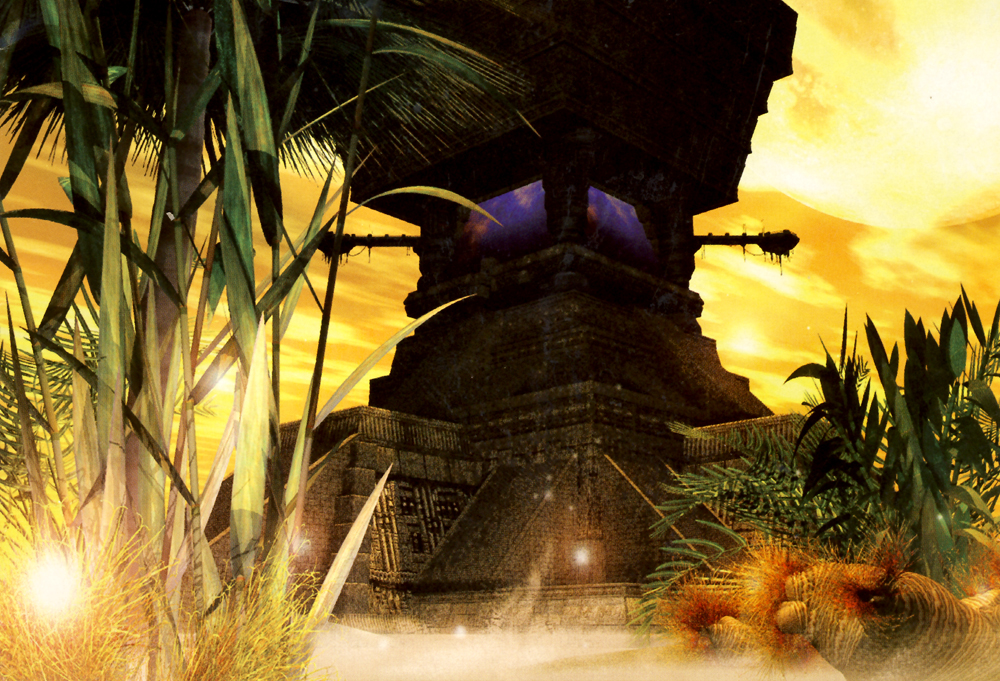
Jedi Temple on Ossus after the Vongforming
The Galactic Alliance gradually finished rebuilding itself a few years later, but it never would be the same as the pre-invasion New Republic. Some time after 41 ABY, as part of a move to improve relations between the Yuuzhan Vong and the rest of the galaxy, the Galactic Alliance's New Jedi Order permitted Yuuzhan Vong Shapers, headed by Master Shaper Nei Rin, to use a desolate portion of Ossus, one of the order's most ancient strongholds, as a test site.
The intent of those who championed the project—such as Jedi Master Kol Skywalker, a leading member of the Jedi Council—was to see if Vong terraforming methods, such as those that had once transformed Coruscant into the species' temporary homeworld of Yuuzhan'tar (27-29 ABY), could restore the barren and devastated world. Though most of the species had left for the Unknown Regions on Zonama Sekot, enough shapers remained to start a pilot program on the world. The experiment appeared to work, returning vibrant life to Ossus, and when the Jedi revealed the results to the outside galaxy, other worlds vied for the chance to restore planets the Yuuzhan Vong War had left devastated.
Ultimately, one hundred planets were chosen for terraforming. Yuuzhan Vong Shapers, accompanied by Jedi, set to work, and at first the results were wondrous to behold. Unfortunately, none had reckoned with interference by the One Sith. On the command of the cult's leader, Darth Krayt, the Sith secretly sabotaged the terraforming process on these worlds. Plants grew deformed, and painful bony growths, of a kind not seen since the Vong forcibly took populations as slaves, sprouted from the skin of the inhabitants, killing millions in the process.
The Jedi suspected sabotage, but did not know who was responsible. All across the galaxy, however, blame fell upon the Yuuzhan Vong. Far too much animosity still existed against the former invaders for many to believe they had truly given up their ambitions of conquest. The Jedi however, were certain that the Yuuzhan Vong were innocent, and convinced the Galactic Alliance to support the Yuuzhan Vong against domestic criticism.
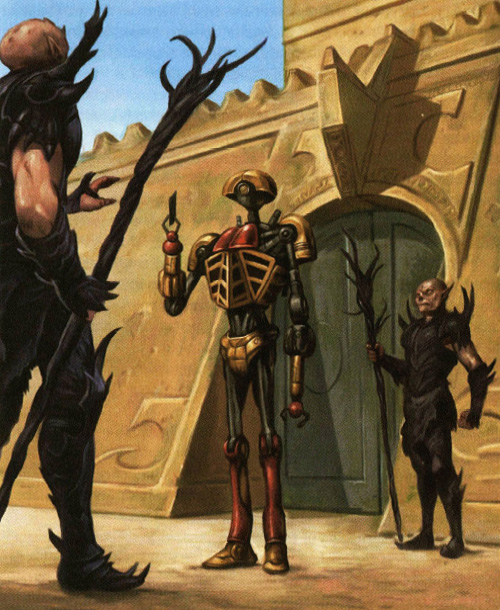
Two Yuuzhan Vong confronting an FEG-series pilot droid
This turned out to be too much for the Empire. The signing of the Pellaeon–Gavrisom Treaty (19 ABY), had brought peace between the Imperial Remnant and the New Republic, and the war against the Yuuzhan Vong had all but united the former rivals. However, the Moff Council still contained many hardliners who sought to restore the Empire to primacy as the dominant galactic power. Calling for retribution and invoking the Treaty of Anaxes, they declared war on the Galactic Alliance. The peace that so many had fought and died for in decades past was undone in a stroke, as the Sith had planned.
Fearing what could ultimately happen, the Jedi High Council ordered the creation of the Hidden Temple at the start of hostilities, its location chosen by Nat Skywalker so the Jedi could have a refuge.
From the start, the Alliance was handicapped. Its defense of the Yuuzhan Vong had alienated numerous member worlds, whose populations still nursed bitter memories of the Vong invasion, and many of them refused to support the GA. Suddenly, the Alliance found itself facing a secessionist movement as well as general war. The Empire used this to its advantage, luring some of these disaffected worlds into the Imperial camp and weakening the GA government. Other worlds, like Hapes, declared neutrality. Thus, the war started with the Empire having all the advantages, save one: Despite this, Emperor Roan Fel himself was less than enthusiastic; he had only reluctantly declared war and thus never threw his full support behind it, even going so far to prevent his Imperial Knights from participating.
It was at this time that things were not going smoothly for the Fel Empire: despite the Alliance handicap, the Jedi were more than making up for that. Also, because Roan Fel refused to let the Imperial Knights enter the war, the Empire didn't have the strength necessary to counter the Jedi. Soon, the Sith inserted themselves into the war, offering to compensate for the lack of Force users that was the great hole in Imperial warfare. Through Moff Nyna Calixte, the ruthless and ambitious Director of Imperial Intelligence, the Sith approached the Empire and allied themselves with the Imperial cause. When the Sith then declared themselves openly, the Jedi quickly realized that it was they who were responsible for sabotaging the Yuuzhan Vong terraforming projects though the Order was never able to definitively prove it. As events progressed, even members of the Imperial regime—including Emperor Fel himself—realized the truth, that they had been used as pawns in the One Sith's plan for galactic domination. Sadly by the time the true motivations of the Sith had been made clear to Emperor Fel it was far too late to halt the designs already set in motion. The Yuuzhan Vong, upon learning the truth, were at first relieved that it was not the work of their gods, were then determined to reverse the damage the sabotage had caused. Shaper Nei Rin journeyed from Ossus to try to discover the Sith's method of sabotage, hoping that this knowledge could help discredit the Sith and end the war.
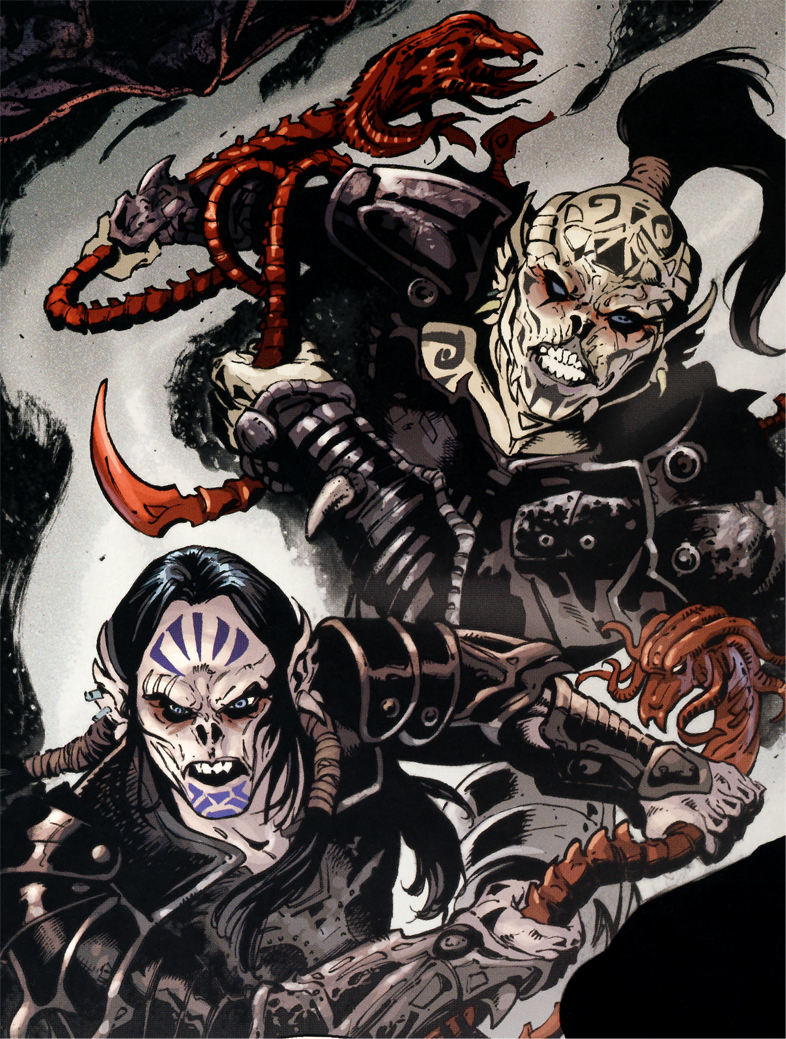
Yuuzhan Vong over a hundred years after the war's end
After three years of bloody warfare, the Galactic Alliance was a spent force, while the Sith only grew in power and strength, even independently manufacturing and fielding their own starfighters. Imperial forces had even retaken Coruscant after more than a century. The Alliance finally surrendered, and its territory was absorbed into the Empire. It is unknown if the Empire made any efforts to exterminate the Yuuzhan Vong. The Emperor called on the Jedi Order to surrender and subject itself to the will of the Empire. Some of them did, becoming the Imperial Knights. But the rest, remaining true to the will of the Force, refused to ally themselves with the Sith and withdrew from Coruscant to their temple on Ossus. The Sith eventually followed the Jedi there. Darth Nihl, former Nagai warlord turned Sith, led a brutal attack on Ossus, aided by Imperial forces led under Moff Rulf Yage. The Massacre at Ossus scattered the Jedi across the galaxy, though the order was not yet entirely defeated. Nei Rin returned to Ossus the day after with proof that the Sith had been behind the projects sabotage, but unfortunately too late to stop either the war or the massacre.
Shortly after, the Sith, determined to rule the galaxy themselves, turned against Emperor Roan Fel and his Imperial Knights. After killing what he later determined to have been a double of the Emperor, Darth Krayt assumed the Imperial throne himself, restoring, for the first time in over a century the rulership of a Sith as Emperor, and becoming the first Sith Lord since Darth Caedus to rule over most of the galaxy.
Though most of the Yuuzhan Vong who accompanied the Jedi in the Ossus Project were slain, three managed to survive where they remained beneath the Jedi Temple and guarded the remains of the dead Jedi out of respect for the Jedi Order. Master Shaper Nei Rin had been off planet investigating why the project had gone wrong, but arrived back at Ossus with her findings too late to stop the War or the massacre. Shortly afterwards, Rin, her guards, and a few Jedi who had returned to the world were hiding from an Imperial patrol under the temple when the patrol's Sith commander ordered the Academy destroyed from orbit. Luckily, thanks to Jedi Master K'Kruhk, the occupants managed to survive.
After some time, it was revealed that a fanatical Yuuzhan Vong named Zenoc Quah had survived the war and had hid on Wayland for over a century before allying with the One Sith to sabotage the Ossus Project. Seven years later, he was a part of Darth Maladi's plot to overthrow Darth Wyyrlok from the rule of the Empire as well as put a new, more powerful Dark Lord at the helm. Quah and Maladi worked at creating a new weapon that would secure their hold on the galaxy from dissident Sith. For this purpose, Maladi and Quah set up a trap to capture Cade Skywalker as their test subject.
Due to their beliefs, the Yuuzhan Vong were opposed to technology, ranging from simple machines to droids, which they believed were a polluting influence. As such, all examples of their technology consisted of living biots: creatures that were born and bred for their tasks. They preferred the use of such creatures over lifeless machines which lacked any form of spirit. All Yuuzhan Vong technology, whether it be starships, weapons, or simple everyday objects, was entirely biological. They hated droids, machines, electronics, and anything manufactured. This biotechnology was coaxed into growth by the Shapers and seemed to be more resilient when compared to conventional technology.
Notable pieces of technology included their feared yammosks, which were called war coordinators due to the fact that they served as a biotic Battle Analysis Computer and had the capacity to coordinate Yuuzhan Vong forces to a frightening degree. Through their villips, they had managed to create a communication system that rivaled the galactic HoloNet. Different breeds of such organisms were also capable of producing living light holograms which the Yuuzhan Vong had mastered for centuries. It was known that their collision avoidance systems were as good as those of the inhabitants of the galaxy. Furthermore, their equivalent of an antenna consisted of spiral fibers embedded in a yorik coral hull to regions which were sensitive to receiving communications. In addition, they made use of nutrient feeds for various biots which served in a similar capacity as power lines did for their technological equivalents. Similar to navigation computers, the Yuuzhan Vong vessels possessed navibrains that were required to plot hyperspace jumps. Their vessels were also required to rearm themselves after combat with the process noted as being marginally better than those of the technological inhabitants of the galaxy.
Yuuzhan Vong personal weaponry included living serpentine weapons called amphistaffs that were able to alter their form allowing their user to use them as a spear or a whip. Furthermore, they wore Vonduun Skerr Kyrric armor which was capable of protecting them from weapon fire as well as lightsaber strikes. Their larger coral shaped craft made use of Yaret-Kor plasma weapons that ate through the hull of enemy ships while shielding was provided by the gravity manipulating dovin basals that generated singularities that were used to protect the craft from enemy weapon fire and were also capable of stripping the shields of enemy vessels. These organisms were grown independently and later grafted onto other organisms in an imperfect symbiosis In addition, they generated powerful gravitic fields that could also create interdiction fields that left living occupants unconscious after being pulled from hyperspace. Larger, more insidious weapons included biological plagues capable of destroying entire worlds. Some plagues were unleashed that left planetary systems barren and incapable of growing food.
The primary construction method through which the Yuuzhan Vong created their living vessel was through the use of yorik coral. This coral-type substance formed the hull and internal anatomy of their vessels. While several other races had mastered bioengineering, the Yuuzhan Vong were one of the few that had developed a mass production means of creating such organisms. They were capable of growing coralskippers in less than a month's time, which matched the production rate of the Incom Corporation X-wing but had the benefit of not producing any waste material from normal industrial techniques. The outer skin of such craft, despite being alive, did not feel anything in the vacuum of space as the nerves were not exposed to the cold of the void. They were created to lack any nerve endings at such locations. Though the outer hull did not possess any nerve endings, the inner hull did and any breach led to alarms being raised, thus alerting the Yuuzhan Vong of intruders. Something not commonly known was that the nerves near the dovin basals were compromised due to the creatures' gravitic nature. As the dovin basals were independently grown, they were nursed separately and later grafted onto their host vessels. However, the symbiosis was not perfect and the gravitic distortion created by the dovin basals desensitized the nerve clusters that were adjacent to it. Amongst warships or any other vessels, the Yuuzhan Vong compensated this problem by implanting special nerve biots around the dovin basal in order to create a complete tactile net that would not be confused by the gravitic anomaly. However, certain low priority ships were not afforded this amenity and thus created blind spots for a breaching action. Inside these ships, much of the systems had technological equivalents such as a central biotic computer like the targeting brain. However, it was sensor systems that were the most different as instead of any externally mounted observatory sensors, the Yuuzhan Vong employed a means of sensing the gravitational distortions of distant objects as a means of scanning.
A key interface element within Yuuzhan Vong biots that linked them to their organic ships and technology were cognition hoods. These organic helmets simply slid on top of an individuals head and were connected by an organic cord linked to the ship itself. Through this contact, a pilot was capable of making a direct interface with the ship and communicating with it. This was the case either with organic pilots and droids which were capable of processing the data being sent to the hood. Onboard larger carrier ships, a central cognition hood was used by the ships commander to deliver commands to the vessel. However, should this hood be severed, then secondary cognition hoods located on smaller craft such as coralskippers were capable of sending commands from the fighter to the carrier vessel thus allowing some level of control. By wearing the hood, a pilot was capable of experiencing the memories of the ship they were linked to thus allowing them to be a part of the ship in question. Yuuzhan Vong ships communicated in the Yuuzhan Vong language which left a language barrier between foreign pilots and the vessel. However, it was possible to impart images and thoughts through the hood to the ship, thus allowing it to be controlled. A much more larger and powerful version of these biots was the cognition throne.
Some of their more famous technologies were the amphistaff, the yorik-et, the dovin basal, the gnullith, the grashal, the ooglith cloaker, the ooglith masquer, the villip, and the yammosk.
- Blast bug (thrown)
- Magma pebble (thrown)
- Plaeryin bol
- Plasma Eel (thrown)
- Nang hul (thrown)
- Razor bug (thrown)
- Snap bug (thrown)
- Yaret-Kor
- Amphistaff (mid-range)
- Claws (short range)
- Coufee (short range, common Chazrach weapon)
- Tsaisi (mid-range)
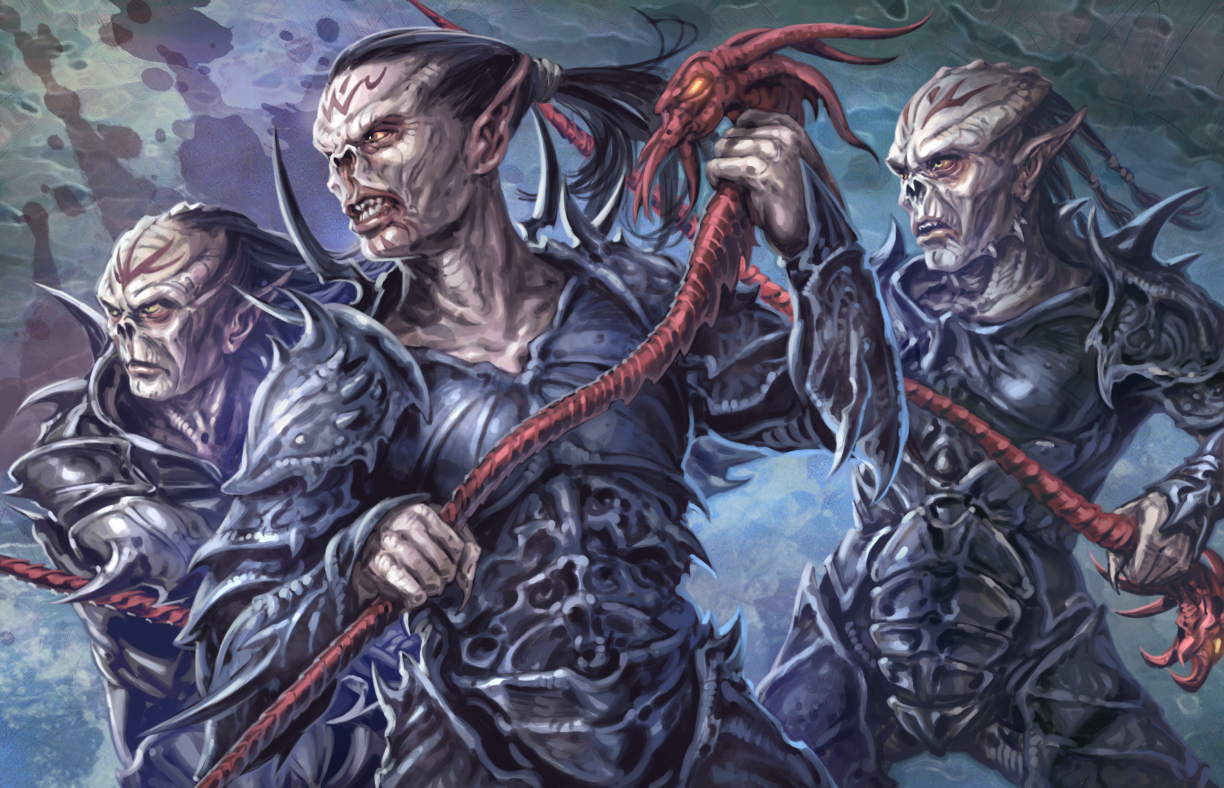
Yuuzhan Vong Warriors
- Nom Anor, a member of the Intendant Caste whose duties included espionage. He was responsible for half of the Yuuzhan Vong invasion of the galaxy and was one of the New Jedi Order's deadliest enemies. Gave Mara Jade Skywalker a nearly deadly sickness. Killed in the Liberation of Coruscant.
- Quoreal, the Supreme Overlord of the Yuuzhan Vong prior to the invasion. Killed by Shimrra.
- Shimrra Jamaane, the Supreme Overlord of the Yuuzhan Vong during the invasion, killed by Luke Skywalker.
- Onimi, Shimrra's jester and a Shamed One. Onimi was a former Master Shaper who added yammosk tissue to his brain, which made him powerful though it also made him "shamed." Seeing a chance of redemption, Onimi made Shimrra, an Intendant, his puppet and ruled the throne from behind the scenes. Killed by Jacen Solo.
- Nen Yim, a Shaper. She traveled to the living world Zonama Sekot with Jedi Master Corran Horn, along with Tahiri Veila, Nom Anor under the guise of the Prophet Yu'shaa and the Yuuzhan Vong priest Harrar, where she learned that the peaceful living world Zonama Sekot is a seed of the original Yuuzhan'tar and that her species have gone terribly astray. She was killed by Nom Anor.
- Shedao Shai, battled Corran Horn for control of Ithor and lost, although the planet was destroyed anyway.
- Tsavong Lah, Warmaster of the Yuuzhan Vong. Tsavong Lah was another of the New Jedi Order's deadliest enemies. He even offered to halt the invasion if the New Republic would turn over the Jedi. He was hideous, with many organic implants built into himself. Tsavong Lah was killed during the Battle of Ebaq, during a duel with Jaina Solo
- Harrar, a Priest of Yun-Harla. He recognized the threat the Jedi represented early on, and consistently advocated their destruction. He traveled to Zonama Sekot with Nen Yim, where the planet's beauty struck him deeply. He was the first to renounce his species violent ways in favor of ending the War.
- Nas Choka, Supreme Commander of the Yuuzhan Vong fleet, and Lah's successor as Warmaster. With the deaths of Shimrra and Onimi, Choka ordered the Yuuzhan Vong to surrender, thus ending the war. He succeeded Shimrra and Onimi as leader of the Yuuzhan Vong.
- Nei Rin, a Master Shaper of the Shaper Caste and ally of the Jedi before, during, and after the Sith–Imperial War.
- Zenoc Quah, a member of the Shaper Caste and One Sith collaborator.
- Viull Gorsat, a member of Garik Loran's reformed Wraith Squadron in 44 ABY. Gorsat, nicknamed Scut, differed from other Vong in that he was raised by a human family.
The name "Yuuzhan Vong" was developed at a French-Thai restaurant in New York City, called Vong, which several Del Rey employees were patronizing. The Yunnan region was mentioned in a list of teas on a menu that Shelly Shapiro—who was present—was reading, and the first draft of the name that would eventually be given to the intergalactic invaders was born of "Yunnan Vong."
The round-robin interview published with The New Jedi Order: The Unifying Force revealed that Yuuzhan Vong were originally planned to be dark-side users. The idea was vetoed by George Lucas, who, while commenting on the story overview, pointed out that dark siders would be unable to function as a group, due to their lust for power.
According to the same interview, the concept of the Yuuzhan Vong's exclusive use of biotechnology came from R. A. Salvatore, and their love of pain was originally confined to Domain Shai, but later authors misunderstood and applied it to the entire species.
As discovered by the Jedi during the war with the Yuuzhan Vong they are apparently "absent" from the Force. In the book The New Jedi Order: The Unifying Force by James Luceno, the reason for this is given. The Yuuzhan Vong are not "absent" from the Force; their entire species has been cut off from it. It is surmised in the novel that this was implemented by the intelligence of their homeworld, the seed of which would one day become Zonama Sekot, because of their war-mongering and hostile conquering of other species.
Yuuzhan Vong culture and religion was heavily influenced by that of Meso-American cultures. Luceno wanted to characterise the Yuuzhan Vong as "tragic wanderers rather than hateful invaders", with Del Rey editor Steve Saffel suggesting taking inspiration specifically from the fates of Maya and Aztec indigenous cultures ("cultures of inherent tragedy") to this effect.

Dave Filoni drew sketches of Vong for The Clone Wars.
The Yuuzhan Vong possess a number of similarities to other species that were introduced within the novels. They share the same fanaticism as the Yevetha, a caste system similar to the Ssi-ruu, and the same exclusive use of biotechnology as the Charon.
At Celebration Anaheim in 2015, Dave Filoni and Pablo Hidalgo revealed at their The Untold Clone Wars panel that before the show was canceled, there had been plans for the Yuuzhan Vong to potentially appear in the Star Wars: The Clone Wars television series. Sketches of the species drawn by Filoni for the show were shown at the panel. The Vong were to be featured in a The X-files-esque episode in which the Yuuzhan Vong aboard their scout ship would perform an abduction trying to assess the strength of the Galactic Republic and what the Jedi were. According to Hidalgo, however, the story would have just implied the origins of the Yuuzhan Vong and they weren't immune to the Force to better align George Lucas' description of the Force.
While the Yuuzhan Vong are no longer considered part of the Star Wars canon and are now classified as part of Star Wars Legends, a similar species known as the Grysk first appeared in Timothy Zahn's 2018 canon novel Thrawn: Alliances. Like the Yuuzhan Vong, they were a threat to the Chiss Ascendancy and from whom an invasion to the galaxy would be imminent, mirroring the Yuuzhan Vong War from The New Jedi Order book series. However, the Grysk did not use biotechnology, were not immune to the Force, and originated in the Unknown Regions instead of an extra-galactic location.